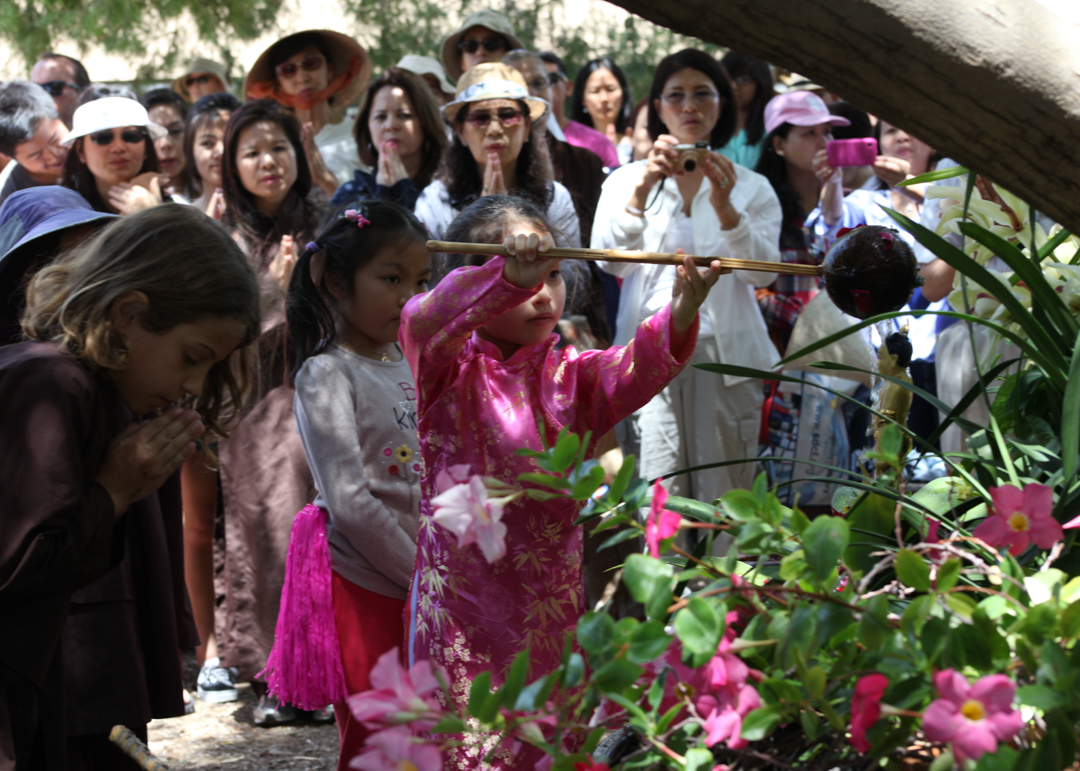A Letter from Thich Nhat Hanh

Dear Family,
The reason Thay must retranslate the Heart Sutra is because the patriarch who originally recorded the Heart Sutra was not sufficiently skilled with his use of language. For this reason, it has caused much misunderstanding for almost two thousand years.
Thay would like to share with you two stories: the story of a novice monk who paid a visit to a Zen master,
A Letter from Thich Nhat Hanh

Dear Family,
The reason Thay must retranslate the Heart Sutra is because the patriarch who originally recorded the Heart Sutra was not sufficiently skilled with his use of language. For this reason, it has caused much misunderstanding for almost two thousand years.
Thay would like to share with you two stories: the story of a novice monk who paid a visit to a Zen master, and the story of a bhikkhu who came with a question to the Eminent Master Tue Trung.
ONE
In the first story, the Zen master asked the novice monk:
“Tell me about your understanding of the Heart Sutra.”
The novice monk joined his palms and replied:
“I have understood that the five skandhas are empty. There are no eyes, ears, nose, tongue, body, or mind; there are no forms, sounds, smells, tastes, feelings, or objects of mind; the six consciousnesses do not exist, the eighteen realms of phenomena do not exist, the twelve links of dependent arising do not exist, and even wisdom and attainment do not exist.”
“Do you believe what it says?”
“Yes, I truly believe what it says.”
“Come closer to me,” the Zen master instructed the novice monk. When the novice monk drew near, the Zen master immediately used his thumb and index finger to pinch and twist the novice’s nose.
In great agony, the novice cried out, “Teacher! You’re hurting me!” The Zen master looked at the novice. “Just now you said that the nose doesn’t exist. But if the nose doesn’t exist, then what’s hurting?”
TWO
The Eminent Master Tue Trung was a lay Zen master who had once served as the mentor for the young King Tran Nhan Tong in thirteenth-century Vietnam. One day, a bhikkhu paid him a visit to ask him about the Heart Sutra.
“Respected Eminent Master, what does the phrase ‘form is emptiness, emptiness is form’ really mean?” At first the Eminent Master remained silent. And then, after a while, he asked:
“Bhikkhu, do you have a body?”
“Yes, I do.”
“Then why do you say that the body does not exist?”
The Eminent Master then continued, “Do you think that in empty space there is form?”
“No, I do not see that there is form.”
“Then why do you say that emptiness is form?”
The bhikkhu stood up, bowed, and went on his way. But the Master summoned him back in order to recite to him the following gatha:
Form is emptiness, emptiness is form is a skillful means created temporarily by the Buddhas of the three times.Emptiness is not form, form is not emptiness –Their nature is always pure and illuminating, neither caught in being nor in non-being.
In this story the Eminent Master Tue Trung seems to contradict the Heart Sutra and challenge the sacred formula “form is emptiness and emptiness is form,” considered inviolable in the Prajñaparamita literature.
Thay believes that the Eminent Master went too far. The Master was not able to see that the mistake doesn’t rest in the formula “form is emptiness.” Rather, it resides in the unskillfulness of the line, “Therefore, in emptiness there is no form.” According to Thay, the way in which words are used in the Heart Sutra, right from the beginning up to the line, “no birth, no death, not defiled, not immaculate, not increasing, nor decreasing,” is already perfect. Thay’s only regret is that the patriarch that recorded the Heart Sutra did not add the four words “no being, no non-being” immediately after the four words “no birth, no death,” because these four words would help us transcend the notion of being and non-being, and we would no longer get caught in such ideas as “no eyes, no ears, no nose, no tongue …” The nose of the novice monk is still sore, even today. Do you understand?
The problem begins with the line: “Listen Sariputra, because in emptiness, there is no form, feelings, perceptions, mental formations, and consciousness.” (1) How funny! It was previously stated that emptiness is form, and form is emptiness, but now you say the opposite: there is only emptiness, there is no body. This line of the sutra can lead to many damaging misunderstandings. It removes all phenomena from the category “being” and places them into the category of “no-being” (no form, feelings, perceptions, mental formations, or consciousness ...). Yet the true nature of all phenomena is the nature of no being nor non-being, no birth and no death. The view of “being” is one extreme view, and the view of “non-being” is another extreme view. It is because of this unskillfulness that the novice monk’s nose is still sore.
The famous gatha ascribed to the sixth patriarch Hue Nang (Hui-neng), in which he presented his insight to the fifth patriarch Hoang Nhan (Hung-jen), also expresses this notion and is also caught in the same wrong view:
Originally, there is no Bodhi tree
The bright mirror does not exist either
From the non-beginning of time nothing has ever existed
So where can the dust settle?
A white cloud passes by and hides the mouth of the cave
Causing so many birds to lose their way home.
The insight of prajñaparamita is the most liberating insight that helps us overcome all pairs of opposites such as birth and death, being and non-being, defilement and immaculacy, increasing and decreasing, subject and object, and so on, and helps us to get in touch with the true nature of no birth/no death, no being/no non-being, etc., which is the true nature of all phenomena. This is a state of coolness, peace, and non-fear that can be experienced in this very life, in your own body, and in your own five skandhas. It is nirvana. “Just as the birds enjoy the sky, and the deer enjoy the meadow, so do the wise enjoy dwelling in nirvana.” This is a very beautiful sentence in the Nirvana Chapter of the Chinese Dharmapada.
The insight of prajñaparamita is the ultimate truth, transcending all conventional truths. It is the highest vision of the Buddha. Whatever paragraph in the Tripitaka, even in the most impressive of the Prajñaparamita collections, if it so contradicts this, it is still caught in conventional truth. Unfortunately, in the Heart Sutra we find such a paragraph, and it is quite long.
That is why in this new translation Thay has changed the way of using words in both the original Sanskrit and the Chinese translation by Huyen Trang (Xuan-Zang). Thay translates as follows: “That is why in emptiness, body, feelings, perceptions, mental formations, and consciousness are not separate self entities.” All phenomena are products of dependent arising: that is the main point of the Prajñaparamita teaching. Even insight and attainment do not exist as separate self entities. This concept is as important as the concept “form is emptiness.” Thay also has added “no being, no non-being” into the text. No being, no non-being is the deep vision of the Buddha stated in the Katyayana Sutra, when he offered a definition on right view. These four words, no being, no non-being, will help future generations not to suffer from a twisted nose.
The Heart Sutra was intended to help the Sarvastivadins relinquish the view of no self and no dharma. The deepest teaching of Prajñaparamita is the emptiness of self (atmasunyata) and the emptiness of dharma (dharmanairatmya) and not the non-being of self and dharma. The Buddha has taught in the Katyayana Sutra that most people in the world are caught either in the view of being or non-being. Therefore, the sentence “in emptiness there is no form, feelings …” is obviously still caught in the view of non-being. That is why this sentence does not correspond to the Ultimate Truth. Emptiness of self only means the emptiness of self, not the non-being of self, just as a balloon that is empty inside does not mean that the balloon does not exist. The same is true with the emptiness of dharma: it only means the emptiness of all phenomena and not the non-existence of phenomena. It is like a flower that is made only of non-flower elements. The flower is empty of a separate existence, but that doesn’t mean that the flower is not there.
The Heart Sutra made a late appearance at a time when Tantric Buddhism had begun to flourish. The patriarch who compiled the Heart Sutra wanted to encourage followers of Tantric Buddhism to practice and recite the Heart Sutra, so that’s why he presented the Heart Sutra as a kind of mantra. This was also a skillful means. Thay has used the phrase, “The Insight that Brings Us to the Other Shore,” because in the mantra there is the expression paragate, which means “gone over to the other shore, the shore of wisdom.” Parayana and paramita have both been translated as “crossing over to the other shore.” In the Sutta Nipata there is a chapter called Parayana, which has also been translated as “crossing over to the other shore.”
Dear Family, I hope you enjoy practicing the new version of the Heart Sutra in English. We have an English translation, and Brother Phap Linh is in the process of composing the music for the new chant. The next edition of the Plum Village Chanting and Recitation Book will include this new translation.
Yesterday, on the 21st of August, after finishing the translation at around 3 a.m., a moon ray penetrated Thay’s room.
With love and trust,
Your Teacher
Asoka Institute, EIAB, Waldbröl


